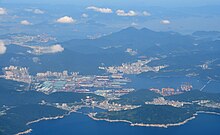Geojedo
Native name: 거제도 | |
|---|---|
 Off the coast of the island, with shipyards and ships in view (2011) | |
 | |
| Geography | |
| Location | Korea Strait |
| Coordinates | 34°51′29″N 128°37′06″E / 34.85806°N 128.61833°E |
| Area | 383.44 km2 (148.05 sq mi) |
| Highest elevation | 580 m (1900 ft) |
| Highest point | Gara |
| Administration | |
Republic of Korea | |
| Province | Gyeongsangnam-do |
| Largest settlement | Geoje (pop. 242,077) |
Democratic People's Republic of Korea (claimed) | |
| Province | South Kyōsang Province |
| Demographics | |
| Ethnic groups | Korean |
| Korean name | |
| Hangul | 거제도 |
| Hanja | 巨濟島 |
| Revised Romanization | Geojedo |
| McCune–Reischauer | Kŏjedo |
Geojedo (Korean: 거제도; MR: Kŏje-do), or Geoje Island, is the principal island of Geoje, South Gyeongsang Province, South Korea. It is joined to land by two bridges from nearby Tongyeong. Gohyeon is the largest town on the island.
Geojedo covers an area of 383.44 square kilometres (148.05 sq mi), the second largest island in South Korea, after Jeju Island. The landscape features several peaks: Gara (580 metres, 1,900 ft), Daegeum (437.5 metres, 1,435 ft) and Guksabong (400 metres, 1,300 ft). Geojedo is known for its rich deposits of granite. The southern belt of Geojedo, together with part of Namhaedo in Namhae County, belongs to Hallyeo Maritime National Park.[1]
Geojedo features several natural harbors. Shipbuilding is the largest industry on the island.[1] The second and third largest shipyards in South Korea are both located on the island, Daewoo Shipbuilding and Marine Engineering (DSME) in the city of Okpo, and Samsung Heavy Industries (SHI) in the city of Gohyeon (Geoje City).
The Busan–Geoje Bridge was opened in December 2010 and provides a more direct connection to the city of Busan.[2][1]
Etymology
[edit]The name comes from Korean Geoje 'Great Crossing Island'; from 巨 'great, large' 濟 'crossing, ferry' and 島 'island'.
History
[edit]During the Three Kingdoms period, Geojedo corresponded to one of the twelve states of Byeonhan (변한) state called Dokno (독로국; 瀆盧國). During the Silla period (신라시대), King Gyeongdeok in 757 A.D. first started to use the name Geoje County (거제군) to refer to the island.[1]
In the Korea and Joseon dynasty period, after the area called Giseong (기성현) was divided from Geoje 거제현 in 1914, the Geoje area was mistakenly called Tongyeong (통영군).[1] During this period, the island was a strategic location between Japan and the Korean Peninsula, and therefore suffered invasion by the Japanese.
When the Japanese invaded Tongyeong in 1592, the Navy Headquarters of Three Provinces was established in Geoje which served as a command for many naval battles in the area. Included in these were the battle of May 1592; Admiral Yi Sun-sin led Korean forces to a much celebrated naval victory at Okpo, Geojedo (옥포해전), as well as on the 28th of July, 1592 at Gyeonnaeryang (견내량해전) also known as the Hansan Great victory (한산대첩). In the year 1597 the first and only naval defeat to the Japanese in Korean history took place at Chilcheon, Geoje (칠천량해전).
During the Korean War, UN Forces established the Geoje POW Camp in 1951 for captured North Koreans.[3] 31 prisoners died during conflicts there.[4]: 259–60 Koje Unscreened (1953), written by journalists Alan Winnington and Wilfred Burchett, focused on the poor conditions in the camp.[5][6]
In 1953, Geoje became an independent county, and in the early 1970s the shipbuilding industry began producing ships, which led to population growth. In 1995, Geoje finally had a large enough population to be classified as a city (시).[1]

It is now the hub for a major driving force in Korea's economic development, the shipbuilding industry.[1]
Geoje is the hometown of two Presidents of South Korea: Kim Young-sam (1993–1998)[7] and Moon Jae-in (2017-2022).[8]
It was the final port of call of the SS Meredith Victory at Christmastide 1950, when that ship evacuated some fourteen thousand North Korean civilians from Hungnam.[9]
See also
[edit]References
[edit]- ^ a b c d e f g "거제도 (巨濟島)", Encyclopedia of Korean Culture (in Korean), Academy of Korean Studies, retrieved 2024-06-10
- ^ "Fixed link connects Busan, Geoje Island". The Korea Times. 2010-12-13. Retrieved 2024-06-10.
- ^ 양, 영조, "거제도 포로 소요사건 (巨濟島 捕虜 騷擾事件)", Encyclopedia of Korean Culture (in Korean), Academy of Korean Studies, retrieved 2024-06-10
- ^ Hermes, Walter (1992). United States Army in the Korean War: Truce Tent and Fighting Front. United States Army Center of Military History. ISBN 9781410224842.
 This article incorporates text from this source, which is in the public domain.
This article incorporates text from this source, which is in the public domain.
- ^ D. McFarland, Keith (2009). The Korean War: An Annotated Bibliography (ebook). Taylor & Francis. pp. 303–304. ISBN 9781135223953.
- ^ Edwards, Paul M. (1998). The Korean War: An Annotated Bibliography. Greenwood Press. p. 223. ISBN 9780313303173.
- ^ 최, 진 (2008-10-31). "대통령의 아버지, 누구인가?…가난한 농사꾼에서 거제도 갑부까지 ⑤". 중앙일보 (in Korean). Retrieved 2024-06-10.
- ^ 김, 영동 (2017-05-09). "문재인 고향마을 "거제서 대통령 두명이나 될 것 같다"". The Hankyoreh (in Korean). Retrieved 2024-06-10.
- ^ Productions, RJ McHatton of Inventive. "Home - Ship of Miracles Documentary by RJ McHatton". www.shipofmiracles.com.
External links
[edit]![]() Media related to Geoje Island at Wikimedia Commons
Media related to Geoje Island at Wikimedia Commons
